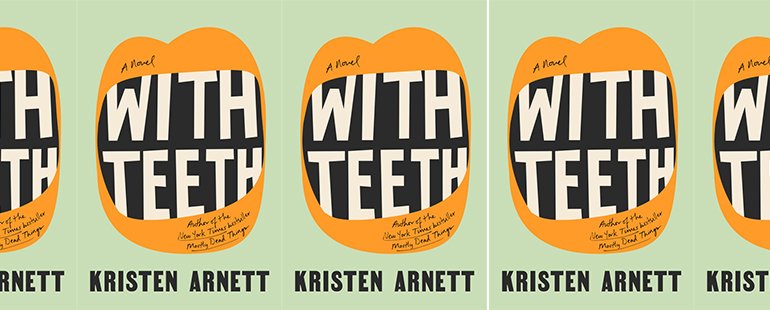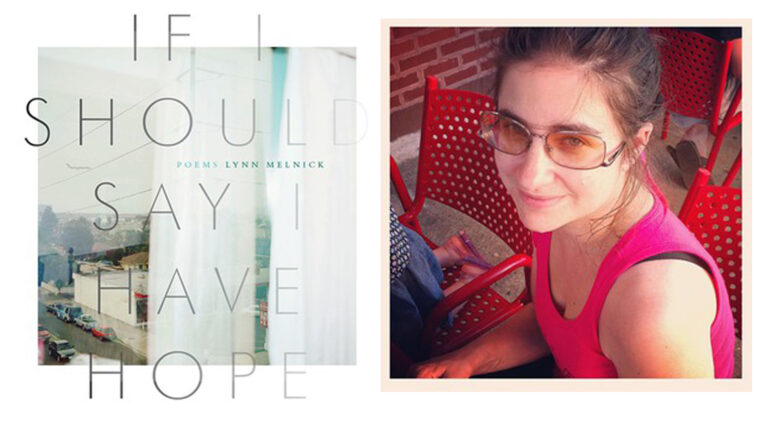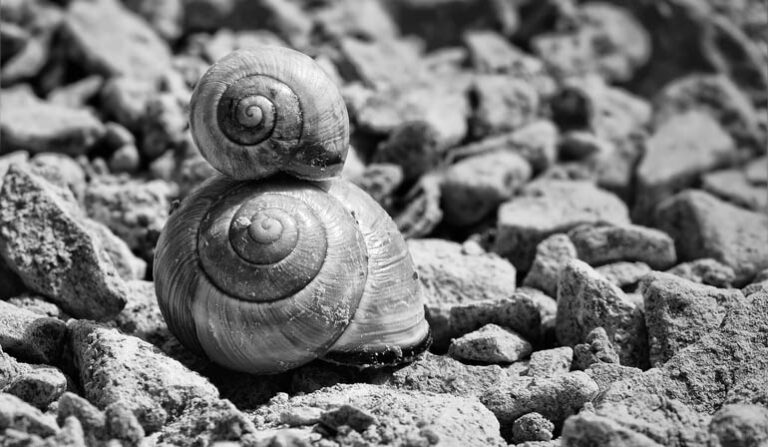“People are messy. What does it even mean to be likable?”: An Interview with Kristen Arnett

Little Samson had just learned to work the swing by himself, allowing Sammie to turn away for a moment to gather their things from the park. When she turned back, her son was being led away by a stranger. Though Sammie thwarts this attempted kidnapping, wrangling her son back into her arms, this event becomes the catalyst for the disintegration of Sammie’s life. After this encounter, her marriage to Monika transforms into a wreckage, Samson grows from a rogue fourth-grader with a biting habit into an openly rebellious and sullen teen capable of violence, and Sammie is left questioning her parenting skills, her absent support systems, and the claustrophobic feeling that comes with being a queer mother in Central Florida.
Kristen Arnett is, in part, a place writer. You can feel the humidity in the air, the dense, wet stickiness of Florida throughout her second novel, With Teeth. Roaches hide beneath appliances, lizard skeletons adorn pathways, and sweating inside this atmosphere of coastal flora and fauna is Sammie, desperately trying to be a good mom. She works on the obligatory craft projects and schleps Samson to and from extra-curriculars, but there is little to hold Sammie up in return. Gay-friendly spaces are focused on the singles scene, there’s not a queer mommy group she can join, and the close people in her life seem to be either withering around her or out seeking cooler climes. Sammie is thus lonely and confined, trapped in motherhood and left in a vacuous state of perpetual longing. “She missed the queer people she’d hung around with when she was single, back before she’d turned into a Gay Mom,” Arnett writes. “She always thought about it that way, in capital letters, because that’s what happened: you turned from a Queer Woman into a Queer Mother, and suddenly your old life and friends didn’t fit the vibe of your new life.”
While Sammie does have Monika, whose parenting style complements her own, their relationship suffers from the exhaustive heat of new parenthood, and they begin to grow further and further apart. There are others around Sammie, too, but none of them are quite what she needs. Their voices—Samson’s elementary teacher, his therapist, a fellow parent, a coworker, and many others—are woven throughout the novel in short sections of interior monologue that showcase a wide variety of perspectives, and which differ from Sammie’s thoughts and feelings. And in the end, they collectively tend toward opposition, bringing Sammie’s reliability as a narrator into question. When a young Samson splashes all the fish out of the giant tank in his therapist’s waiting room, for instance, the fish dying on the floor around him, Sammie’s reaction seems restrained: “All the blood surged into Sammie’s brain, so quickly she thought she’d pass out. Her legs felt disconnected from her body. She didn’t even realize she was hyperventilating until Samson’s therapist reached over to touch her.” But the perspective of Dr. Kim the therapist is disparate: “It was his mother’s reaction that had bothered her. No, bothered wasn’t exactly the word. His mother had scared her. The way she’d screamed, and how she’d looked at the boy immediately after, with a mixture of love and revulsion.”
Much of With Teeth, out this week, becomes about this very notion—how we craft our stories to fit our needs, especially when we feel trapped, or frightened. For Sammie, the cyclical nature of motherhood—the repetitive schedule of holidays, playdates, and school—forms a stagnancy that can only be combated by the messiness of life, by fully letting herself go, by living truthfully to herself, regardless of what doing so causes others to think. So as the household adjusts to the circumstances of the life whirling around them, Sammie, too, must decide where she goes from here, and who she’ll allow herself to become.
Although With Teeth explores the disintegration of a marriage, the often brutal circumstances of parenting, and the complexity of rendering a new and purposeful life amidst great turmoil, Arnett (a former contributor to the Ploughshares Blog) doesn’t leave us busted and sad. The varied perspectives keep us rooting for everyone: for Samson to come out of his teenage turmoil with confidence and balance. For Monika to find what she’s looking for in a relationship and disregard any judgment of it. And for Sammie to feel the comfort and support she needs and deserves as a queer mother in the rampant heat of Central Florida. Arnett allows every perspective to shine and every voice to be heard, which, in the end, might be all Sammie ever really wanted.
J. A. Tyler:Let’s start with teeth. The grins, the bites—the novel is riddled with mouths and teeth. Did the book begin with teeth, or did it start instead with a notion of children and motherhood?
Kristen Arnett: It definitely started with the idea of queerness and motherhood, for sure. I was thinking a lot about what it’s like to be queer and live in places like Central Florida where there are tons of gay people, but not actually very many queer-oriented spaces. It’s extremely limited. Those places quite often also cater to a specific kind of queerness—single and young, like bars and clubs. So what would it be like to migrate from one point of your life (young and single) to another (married with kids), when there are no places for you? There aren’t any gay mommy groups, none of that. You’d feel alienated from your community. On top of that, what if you’re just not so great at being a mom? There would be so much pressure there, to be perfect because people are always judging you for your non-heteronormative family situation, but also to be perfect because you don’t want to ruin it for everyone that comes after you. Judged by everyone!
JAT: At one point, Sammie likens existence to a snow globe, which has an internal beauty but also represents the idea of being trapped, confined, and controlled. Is existence a cage, with people always looking in or out?
KA: I think it all comes down to perspective. For Sammie, I wanted to portray what motherhood can occasionally feel like—this idea of claustrophobia, being contained, trapped. So much of her time is either spent inside the house or inside the car, moving her child from point A to point B and then coming home and doing it all over again the next day. I think it can be very easy to set ourselves up for failure when we move into a place where life feels stagnant. The snow globe is a great example of that. It’s beautiful to look at, sure, but the water inside is undrinkable. It’s a stagnant mess.
JAT: How did you come to choose seasons as dividing marks for the book? How important is their cyclical nature to the novel?
KA: A lot of time with kids naturally falls into those rhythms, I think. Summer break. Winter with its family holidays. Spring and spring break, fall, and the start of school. I think once people become parents there is this natural inclination to base everything around the seasons of their child’s life. I’m not sure that adults without children do that as often. I know when I was working at the public library and running storytime, so much of our programming had to exist inside this seasonal kind of work. Now this is happening for the kids, now this, now this. Your life becomes a calendar, the pages flipping past, and then it’s the next year already, and now, look, four years have passed! Time is a flat circle, all divided up by seasons.
JAT: The novel both opens and closes with the convergence of screams and speechlessness, almost as if when one character has a voice, it supersedes the others. How significant is the dominance of voices to Sammie, to Samson, to Monika?
KA: We get to see so much from Sammie’s perspective because I very much wanted her voice to be the loudest. Being the loudest doesn’t always mean being right, however, and I think we all know that! But it was important for me to focus on Sammie because in her mind, she feels as though no one’s ever listening to her. I think that many people can feel this way, and I definitely think it happens in queer communities—this idea of silencing certain voices—but I wanted there to be a look at who gets to do the talking in a household, too. Who is heard? We don’t hear as much from Monika, but I think that’s because Sammie does her fair share of not listening. And it is always interesting to look at how children factor into a household. Kids retain a lot and understand much more than we give them credit for, but I think that parents can sometimes have this compulsion to think that kids don’t need to speak, because they’re being spoken for. It was interesting to play with those dynamics with these three characters.
JAT: You have given us little snippets of various other characters too, these short, one-shot glimpses into ancillary characters. How did it come about, to pepper the novel with these additional perspectives?
KA: The interstitials felt crucial to include. We get a lot of Sammie and she’s not always the most reliable narrator, but I would argue that everyone inside a household has divergent ideas about situations and none of them are exactly correct. I wanted there to be moments where strangers, or even just acquaintances, had the opportunity to comment on moments that involved Sammie, Samson, and Monika. I think that tells us more about the family than anyone inside the family can accurately relate. What do outsiders, who have no information about what’s really going on in the household, see when they look at these three? Or even when they interact with Sammie? That felt important.
JAT: There is rain, lightning, and humidity throughout, a devout and resounding capture of Florida as a landscape. How important is the wetness (and fauna—including roaches and lizards) of Florida to your writing process?
KA: I consider myself a place writer, a Florida writer specifically, so I would say that the natural environment here is pretty significant to my continued writing. Florida is a big personality, something I consider almost like a character in my work, because it’s the kind of place that is going to touch you, going to be involved in every part of your daily life. The weather, the insects, the damp, and the heat and humidity—all of this is part of Florida. It’s going to sit inside the work, for sure, so it needs to sit with me. Luckily, I live here, so it’s always going to be around for me to embrace!
JAT: In the end, we are confronted with the unreliability of memory, the idea that we often build private narrations to suit personal needs. At the novel’s conclusion, how reliable is Sammie’s narrative?
KA: I think it’s less about the fact that she’s unreliable than the idea that maybe nobody in a household is ever really telling the whole truth. And I think that’s very, very human. And very, very messy. And, for me, very, very fun!
JAT: I’ve been thinking a lot about the relationship between the author and the work, and I’d love to know, what did this novel give back to you? What did you gain from it as an author, or as a human being?
KA: I think I gained a lot of insight into what I actually thought about queerness and motherhood. Specifically, how I think it fits (or doesn’t fit) inside of queer spaces in Florida. I think it also gave me a lot to think about when it comes to “likability,” a thing that people have a lot of opinions about. People are messy. What does it even mean to be likable? And isn’t likeability itself a kind of self-branding, a way in which we mold ourselves and our characters toward respectability? No thanks. Give me the unlikability every time.
JAT: The novel’s epigraph is from Flannery O’Connor. How important is her work to you? Who else ignites your writing?
KA: I did my honor’s thesis on Flannery O’Connor’s novels, so I think she’ll always sit very close to my heart. She’s an extremely southern writer—a place writer—and she’s entrenched in short fiction work, which is a favorite of mine, so I’ve always felt tenderly towards her. She’s also a writer that has always leaned into the messiness of humanity, and god knows I love that. People who are ugly and mean sometimes, people who aren’t always good. There are so many other writers I look to when I think about work! Especially Florida writers. T Kira Madden is one. She writes so beautifully about queerness and the beauty in ugliness. I’m also very attracted to the work of Dantiel W. Moniz, a writer who has the ability to write complex, fascinating characters that live inside spaces of moral flexibility. She writes about place so wonderfully, too.
JAT: Who have you been reading most recently? What newly released books have really knocked your socks off?
KA: I have been loving a lot of new work! Crying in H Mart by Michelle Zauner was gorgeous. Really loved Infinite Country by Patricia Engel (who is also a Florida writer). I’m just starting Peaces by Helen Oyeyemi and it is delightful. Looking forward to a summer of even more reading!
This piece was originally published on June 2, 2021.


